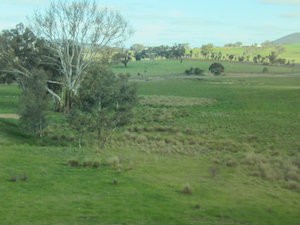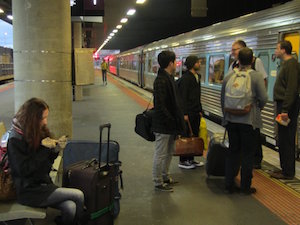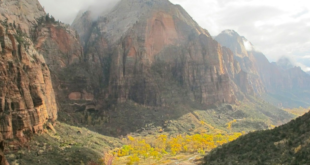David was big and broad and beaming, and he greeted us with a smile and an expansive wave that took in the length of “his” train.
 It was 7.55am, and we had been up since 6 o’clock, packing final bits and pieces, double-checking cupboards, the bathroom, drawers, the fridge and under the bed for those easily-overlooked items. We’d already had a magic few days in Melbourne, one of our most favourite cities, and, as we have done previously, we were leaving with the vow that we must return “and spend at least a fortnight so we can have a proper look around”. In the four days we had just spent there we had discovered there was so much more to discover: nifty little malls and huge shopping centres; magnificent old churches and beautiful libraries and art galleries; eateries serving every imaginable type of food and drink; walks and parks and the delights of watching and listening to the street performers and buskers in the extensive Bourke Street pedestrian mall.
It was 7.55am, and we had been up since 6 o’clock, packing final bits and pieces, double-checking cupboards, the bathroom, drawers, the fridge and under the bed for those easily-overlooked items. We’d already had a magic few days in Melbourne, one of our most favourite cities, and, as we have done previously, we were leaving with the vow that we must return “and spend at least a fortnight so we can have a proper look around”. In the four days we had just spent there we had discovered there was so much more to discover: nifty little malls and huge shopping centres; magnificent old churches and beautiful libraries and art galleries; eateries serving every imaginable type of food and drink; walks and parks and the delights of watching and listening to the street performers and buskers in the extensive Bourke Street pedestrian mall.
But now we were Sydney-bound, aboard the XPT (express passenger train) Service Trainlink. We trammed our way from a central-city hotel to the Southern Cross Railway Station, found Platform 1 and our train, and after buying take-away coffee quickly established there are no rubbish bins in the station. They could too easily be used as deposit sites for terrorist bombs, we were told. Instead, rubbish is left on platform seats and collectors with big plastic bags circulate regularly to pick it up. I privately hoped rubbish collectors get paid danger money.
Lots of people in Australia travel by train, both in the nation’s major cities of Perth, Adelaide, Melbourne, Sydney and Brisbane, and also around the vast country as well. Just out of interest I checked on one of the trips that top my bucket-list, the Indian-Pacific train journey from Sydney to Perth, via Adelaide. More than three million travellers have so far made that trip, and we want to do it too, some time soon. It’s a three-nighter, covering more than 4350km, and will probably cost us about $A4500 for a twin sleeper compartment. But we just gotta do it!
On the Melbourne – Sydney XPT Services run, there are two trains a day each way, seven days a week, with each train carrying 350 to 500 passengers, and up to 700 during holidays and other busy periods. That’s close to 2000 passengers every day going from one city to the other, and the occasional stop-off in between. That equals about 14,000 people a week; more than 700,000 a year. The Melbourne-Sydney line is one of the busiest in Australia. Its popularity is matched closely by the Sydney-Brisbane line.
A seat-pocket brochure on the XPT showed a centre-page spread displaying a network of rail lines running all over New South Wales – to Canberra, Griffith, Dubbo, Moree and Armidale, and no doubt they carry large numbers of travellers on their 4ft 8½-inch (1435mm) standard-gauge tracks. It’s a great method of shifting lots of people over substantial distances in reasonable comfort. It’s also a really good way of seeing lots of wide open country not normally available for viewing.
So, we left Melbourne promptly at 8.30am, smoothing away from the platform with hardly a nudge to indicate we were on the move. There were seven carriages, three first class and four for us plebs, plus a buffet car, and soon we were rocking along in the classic slow-train movement where the carriages roll gently from side to side. We trundled through heavily-graffitied industrial suburbs which somehow always seem to be the preferred route of railway tracks. Weeds, rubbish, inane scrawlings and the rusting and grubby rumps of much of the city’s commercial buildings were all garishly on show.
Yet I find it all fascinating, seeing what there is to see in such places, and looking at the shapes and colours and detritus that is simply chucked out the back and forgotten. But soon enough we were moving at a good clip, the rocking subsided, and we whizzed through some of Melbourne’s more salubrious outer suburbs. There, beautiful houses nested in among gum trees and other bush growth, looking beautiful and peaceful … and perhaps fair game for the next regional bushfire too, I thought. Welded rails meant there was none of the usual clickety-clackety normally associated with railway travel. And we trundled on.
Opposite, and a seat back, an older woman talked – and she kept at it with dogged, unflagging determination for most of the next 11 hours. By appalling bad luck, or maybe just plain miserable happenstance, a young Thai man was trapped in the window seat, and Lady Blathermore made sure she took full and every advantage of the imprisoned gentle and very polite ear.
Meanwhile, William, the passenger services manager, introduced himself via the train’s communications system, and advised us that there were two Davids as well as Heather and Bill aboard specifically for our safety and comfort, and the buffet car would shortly be opening. Big David thereafter detailed the goodies available – “hot pies, pasties and sausage rolls, sandwiches, cakes, plain or raisin toast, hot or cold drinks, lollies …” And, he warned “it is not, repeat not, safe to charge mobile phones or other electronic devices from the on-board power sources” because the train was diesel-powered and the engine’s power flow fluctuated considerably.
 Within 20 minutes or so we were nudging into Melbourne’s outskirts, and the beginnings of rural Australia began wandering past the speeding window. The seats, similar to those in big commercial aircraft, were surprisingly comfortable. They were recliners, each with a fold-out table in front, and there was plenty of leg-room. Suitcases were stowed in a large luggage rack at the end of the carriage, and roomy overhead lockers took hand-luggage. So it was easy enough to sit back and watch the world go by through the big, clean windows.
Within 20 minutes or so we were nudging into Melbourne’s outskirts, and the beginnings of rural Australia began wandering past the speeding window. The seats, similar to those in big commercial aircraft, were surprisingly comfortable. They were recliners, each with a fold-out table in front, and there was plenty of leg-room. Suitcases were stowed in a large luggage rack at the end of the carriage, and roomy overhead lockers took hand-luggage. So it was easy enough to sit back and watch the world go by through the big, clean windows.
We were travelling on a limited-stop train, and we zipped straight through a number of minor stations, including Donnybrook, before making our first stop at Broadmeadows half an hour out. Beyond Donnybrook we had broken into the country proper where there were huge open paddocks showing a mix of short-cropped grass, scruffy weeds and a surprising amount of rock and stones. Here and there the stones had been gathered either into large mounds left haphazardly in the paddocks, or were more carefully stacked into long, broad walls, forming fences. There was one immense paddock holding a series of healthy-looking clumps of gorse, all just coming into flower. But of stock animals there was little sign.
And, of course, there were the gum-trees, dotted across the paddocks or in broad, ragged blocks, and sometimes smothering an entire hillside. Those gum trees are one of my very best favourites, specially the big old-man silver-barks which so often stand aloof and alone in a big paddock with their sturdy gaunt limbless trunks clean and stark for the first five to 10 metres and then spreading out into a broad umbrella of leaf-shredded shade and a smattering of scattered brittle fallen small branches around its feet. Sometimes a flock of shrieking white cockatoos would sweep across a paddock and lurch up into the top branches, all standing out like big bleached leaves.
Much of the land was flat during that first hour or two of travel, with an occasional rolling hill. Out here in the vast Australian countryside it all seems relatively small-scale compared to what else there is around it, though in the more compact Waikato the land and its contours would appear enormous. For a Kiwi kid who grew up in the quiet confines of a dairy farm in the Otewa Valley south-east of Otorohanga, looking at the farmland of another country always intrigues me. I never cease to be astounded at how immense and endlessly expansive Australia is beyond the confines of its cities. The land just keeps going on and on, with only occasionally a farm-house or a large shed or two, and in this eastern sector of Victoria we were now travelling through there were often large piles of split firewood, indicating the locals were catering to a cold winter, just as much of New Zealand endures during its chill winter months.
Big David, from the buffet car, interrupted briefly to advise travellers that “Devonshire teas were available to order – two large warm scones and lashings of cream and jam”. The train hammered on, straight through Kilmore East and Talla Rock. Behind us, Madam Yakkalot was still going strong and the Thai lad was decidedly glassy-eyed.
I was surprised at how many dams the Aussie farmers had created across their land, varying-sized depressions dug or blasted into the paddocks and somehow filled with water, either by natural rainwater run-off or some other method. Right through that lower State of Victoria country dams were very common. Yet I continue to be constantly confounded at how few animals are about. The paddocks, whether flat or on rolling, are immense, some maybe 40 hectares in size, and although they are mostly close-cropped it’s sometimes hard to see what stock may have chewed them down. Now and then I noted flocks of sheep, big lanky slab-sided merinos mostly, with lambs that appeared only recently docked. As well, there was the odd mob of good-conditioned angus steers or cows. But in neither case were there large numbers of animals, which may indicate that grass is not an easy crop to grow out in this country, unless there’s plenty of water. And water is something Aussie doesn’t usually always have in excess.
Further on, around Benalla and beyond, the land to the north of the railway line wanders off into a wide flat plain liberally littered with stunted gums. Here and there was the occasional mob of sheep, maybe 300 to 500 or so. South of the line was a series of rough, rocky hills mostly blanketed in dense bush. It was wonderful country to look at, from both sides, as one has the chance to do when sitting relaxed and comfortable in a carriage. The line wound round the edge of the farmland, and having the opportunity to sit and take in the detail of the land, its animal and bird life, and the array of trees, shrubs, weeds, grasses and other widely-varying herbage was a real fascination. I noted that roads in the little towns and hamlets were sealed, but dwindled quickly within a mile or two and soon ran off into the distance as single-lane dusty red tracks.
I had with me a really interesting book, but the ever-changing view from the windows was way more enjoyable and I read not a word for the whole journey. Instead, I sat there with my notebook and wrote.
We stopped at Benalla and again at Wangaratta, where the buffet car closed while staff reorganised and cleaned it in preparation to handing over to a new Sydney-based staff at the NSW border town of Albury. On and on we trundled, with sheep and gumtrees and blue hills and Lady Yammerjaws all melding into an interesting cocktail of railroad micro-life.
To be continued tomorrow …
By Kingsley Field. Read more here.
Kingsley Field has published two volumes of his columns on observations of life and the outdoors. He is currently working on a third. He can be contacted at kingsley@accuwrite.co.nz









Join the Discussion
Type out your comment here:
You must be logged in to post a comment.